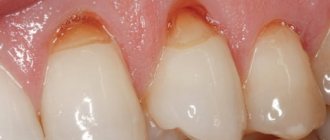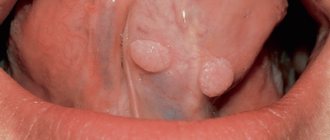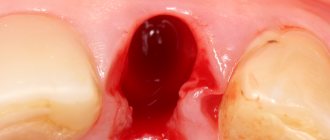Modern dentistry offers various methods to maintain healthy and crystal white teeth. But situations often arise when the only way to save a tooth is to remove the pulp. Although today it is very rare to use materials for canal filling that can change the shade of the enamel, after removal of the nerve, darkening of the tooth surface is observed over time due to its necrosis. Such modifications significantly spoil the smile and cause aesthetic discomfort.
Dentists at the Berezka clinic whiten a dead tooth and after the procedure it is completely no different from other units of the dentition.
Why does a dead tooth turn dark?
Teeth that lack nerves inside are considered dead. The surface of such processes is characterized by a tendency to change color and the appearance of dark spots. The reasons for the darkening of a pulpless tooth are as follows:
- lack of food. After the nerve is removed, the power to the tooth stops. Moisture leaves the enamel, nutrients are not supplied by the nerve endings, which leads to darkening;
- increased vulnerability. Without regular feeding, the tooth becomes very vulnerable. Pores form on the surface of the enamel, through which various coloring substances from the food consumed penetrate into the internal tissues. These dyes change the color of the enamel.
These are the most common reasons why tooth enamel darkens. In such cases, superficial bleaching of the dead tooth will help restore whiteness. But there are also often cases where a tooth has lost its original color due to bleeding during pulp removal. As a result, the enamel becomes reddish or purple. Classic whitening will not provide results in such situations; a more complex procedure will be required.
Removing the pulp of the affected tooth
Pulp removal is a complex dental procedure that requires a highly qualified doctor.
Stage 1 – local anesthesia or general anesthesia
At the first stage of treatment, local anesthesia is administered in the area of the affected tooth. In exceptional cases, the patient may require general anesthesia. The use of anesthetics allows one to avoid preliminary killing of the nerve with arsenic.
Stage 2 – x-ray
At the next stage, the doctor conducts an X-ray examination to determine the length of the root canals.
Stage 3 – pulp removal and tooth filling
All video presentations
After reviewing the x-rays, the dentist:
- gently removes pulp,
- cleans, rinses with antiseptic preparations and fills root canals,
- and then restores the natural anatomical shape of the tooth.
If all procedures are carried out competently, and the patient carefully and impeccably observes personal hygiene, then the service life of a pulpless tooth can reach several decades.
Severe toothache is a consequence of unprofessional dentists
Evidence that the dental operation was performed incorrectly is a sharp toothache accompanied by an increase in temperature. If depulpation is of poor quality, the patient may need repeated surgery. At the same time, aching, mild pain after removal of the dental nerve is considered normal.
Features of whitening at home
Home whitening of a dead tooth is a very convenient method, but in this case it very rarely provides the required effectiveness. This is explained by the fact that at home, as a rule, products are used that only have an external effect. Sometimes such methods are not enough to lighten the enamel and without introducing special components into the tooth cavity it is simply impossible to return it to its natural shade.
At home, whitening gels are usually used, which, after penetrating the enamel, activate chemical reactions in it. It is necessary to work with such substances with extreme caution, since there is a high risk of not only damaging the enamel structure, but also damaging the mucous membranes. Therefore, it is best to trust such procedures to specialists who can prevent possible risks.
In what cases is endobleaching indicated?
All of the above reasons lead to the need for in-canal bleaching:
- when it is not possible to restore the natural shade of the tooth using external influences;
- when a secondary carious process is detected in the tooth cavity;
- with the staining effect of filling material.
The principle of intra-canal bleaching is the same as for any chemical teeth bleaching. A bleaching agent containing hydrogen peroxide is injected into the cavity of the pulpless organ. The cavity is then closed with a temporary filling and left for two weeks to achieve the desired in-canal whitening effect. If the result is not achieved the first time, the bleaching agent needs to be updated with a new procedure duration. Hydrogen peroxide releases oxygen molecules that react with the natural pigment of teeth. We emphasize the word “natural”, since the procedure for bleaching chemical dyes from old fillings often does not give results.
Professional whitening of pulpless teeth
Whitening a dead tooth in a dental office is a completely safe and most effective procedure. One of the popular methods of professional lightening is endobleaching. The procedure is carried out in the following order:
- First, the dentist removes the old filling from the pulped tooth;
- then a special bleaching agent is introduced into its internal cavity. In most cases this is sodium perbonate, if necessary a small amount of hydrogen peroxide is added to it;
- After this, the doctor installs a temporary filling. If it is necessary to re-inject the brightening reagent, the filling is removed again. The number of procedures depends on the degree of darkening of the tooth;
- Once the desired color is achieved, a permanent filling is placed on the tooth.
In addition to intracanal bleaching, the dentist may also suggest other methods, for example, the use of veneers or crowns.
Black teeth in children
The condition of “baby” teeth in children directly depends on the general condition of the body. Color changes can be caused by:
- Disorders of the gastrointestinal tract;
- Dysbacteriosis;
- Taking certain antibiotics;
- Decreased immunity;
- Fungus;
- Calcium deficiency;
- Excess fluoride and a number of other factors.
Just like permanent teeth, caries can develop in baby teeth. If a child’s tooth is black and hurts, then the destruction process has reached the internal tissues - the pulp.
Priestley's Raid
Parents often turn to the pediatric dentist with complaints about black plaque on the teeth that forms in the gum area. Despite its rather frightening appearance, this condition is usually not dangerous. Such deposits are called Priestley's plaque. The reason for black plaque on teeth is the development of the child’s digestive system, its adaptation to “adult” food. When the process is completed, the plaque disappears. But if you find black deposits on your child’s teeth, you still need to see a dentist. Often, caries develops under such plaque. You can stop this process at the initial stage using simple and painless methods.
Contraindications
It is necessary to refuse the intracanal bleaching procedure in the following cases:
- with increased tooth sensitivity;
- for dental diseases and inflammatory processes of the oral cavity;
- if the patient has caries or periodontitis;
- women during lactation should refrain from the procedure;
- Whitening is contraindicated for children and adolescents under 16 years of age.
Any of these factors can lead to undesirable consequences, so if at least one of them is present, you should think about the advisability of whitening and weigh all the possible risks.
Advantages and disadvantages of intra-canal teeth whitening
Advantages:
- The tooth remains intact; its crown part is not ground down.
- The procedure allows you to preserve the aesthetics of your smile.
- Endobleaching has few contraindications.
- The cost of endodontic whitening is lower than the price of installing an artificial crown or veneer.
- The procedure does not cause pain and is safe.
- The effectiveness of endobleaching is at a high level. The tooth actually becomes lighter.
- Takes little time.
Flaws:
- The tooth becomes weaker and more fragile.
- It is not always possible to achieve the desired result from the first endobleaching session.
- In any case, the use of a drill is required.
- After some time, a repeat procedure is required, as the tooth darkens again.
- Several visits are required to completely whiten the tooth.
- If the tooth has darkened not only on the outside, but also on the inside, then regular external enamel whitening will have to be performed.
Whitening prognosis and complications
Whitening a dead tooth is a fairly serious procedure that involves chemical action on tooth enamel. Therefore, before carrying out it, you should familiarize yourself with possible complications:
- the fragility of the result obtained, which necessitates repeated bleaching;
- The enamel of a dead tooth does not always acquire the same shade as healthy teeth. Even after lightening, the enamel can stand out from the rest;
- the enamel coating of a pulpless tooth after bleaching becomes even more fragile, in some patients it even begins to crumble and collapse;
- When applying the whitening component, the gums are irritated, so it should be done with extreme caution in patients prone to gingivitis, periodontitis and other pathologies.
Only a specialist can accurately determine whether intracanal bleaching is worthwhile or whether to look for safer alternative methods.
The Berezka dental clinic employs highly qualified specialists who can be trusted with complete confidence in tasks of any complexity and without worrying about unpleasant consequences.
What happens to the tooth after the nerve is removed?
What happens to the tooth when the nerve is removed? Is it true that it will definitely darken, become brittle and break? Let's take it in order.
Modern dentistry does not imply any color change in the tooth after treatment. Yes, in ancient times they didn’t really know how to treat canals, so sometimes there was an infection in the canals, remnants of the pulp, and all this led to staining over time.
In addition, materials were used for filling that actually changed color over time. For example, resorcinol-formalin paste gave the teeth a reddish-brown tint (in the West they were called “red Russian teeth”), and silver pins and cements containing silver caused the teeth to turn black and blue and sometimes even the gums were stained.
Moreover, if the tooth could still be removed or a regular white crown placed on it, then the gums were forever impregnated with silver. Otherwise it was called silver tattooing. It is impossible to whiten such gums.
Modern methods involve the overwhelming use of gutta-percha when filling the canal, which never causes any staining. All other materials are also designed to avoid staining teeth under any circumstances. So today this process is completely safe for the aesthetic condition of teeth.
Now about the fragility of teeth after depulpation. This is a very persistent myth, which is believed to this day not only by patients, but also by many dentists.
Let us briefly say that in fact there is no special nutrition from the dental pulp that makes the tooth stronger. Also, the tooth does not become “dry and brittle.” Dentinal tubules are equally permeable on all sides, so moisture from the oral cavity enters the dentin in the same way as from the inside of the tooth. And the tooth simply physically cannot dry out in a wet oral cavity.
Many comparisons have been made between the tissues of living and dead teeth, and studies of their tensile and fracture resistance. All these studies have shown that there is no noticeable difference in the strength of living and dead teeth.
At the same time, we often observe chips and breaks of entire walls of dead teeth. What explains this? It's a very simple geometry and biomechanics. While the tooth is alive, its cusps hold tightly to each other with the help of enamel, and the forces acting on separation are extinguished at the very base of the cusp. The leverage of the force is very small.
If the tooth is depulped, then it lacks the main connecting link between the cusps - the lid of the pulp chamber. After all, it is through this place that the doctor enters the tooth canals and performs pulp removal and filling of the canals.
The filling, of course, sticks to the walls of the tooth, but sooner or later the so-called degradation of the bonding (adhesive) layer occurs, and the filling no longer holds the bumps so well. Now they are held on a long wall and have a very long arm that holds the tubercle. This is where a fracture occurs, but not because the tooth has dried out, but because the shoulder and the forces applied to it are too great.
In general, if you don’t go into all these complex details that most people don’t need, the conclusion is this: a dead tooth does not change color and does not become more fragile. But if a lot of tooth tissue necessary to maintain its strength has been lost, then it is better to cover the tooth with a crown.
Side effects of endobleaching
The fact is that any teeth whitening involves chemical destruction of protein dyes. When endobleaching, you have to deal with chemical dyes contained in filling materials. Therefore, initially there is a risk that the effectiveness of the procedure will be quite low. In addition, internal bleaching of a pulpless tooth seriously weakens its strength, since post-bleaching lesions in a non-vital tooth are not restored. Because of this, the risk of dental crown fracture increases significantly. Therefore, endobleaching cannot be performed more than four times.
When is in-canal bleaching required?
Why do teeth darken from the inside? This happens for several reasons. As a result of filling a tooth, when the enamel and dentin come into contact with some types of fillings, staining occurs. For example, a pink color is caused by a resorcinol-formalin mixture, and silver produces gray and black colors. In addition, when the pulp dies due to pulpitis and periodontitis, the tooth first loses its vibrant shine and then acquires a dark shade. The cause of internal staining is the penetration of dyes into dental cracks. These can be various foods and drinks that have a coloring effect, as well as nicotine. The color intensity and penetration depth depend on the size of the cracks.
Thus, internal teeth whitening is prescribed in the following cases:
- if staining of the hard tissues of the tooth occurred as a result of filling the dental canal with coloring materials
- if the hard tissues of the tooth are not amenable to external teeth whitening
How to eliminate darkening of a tooth
If your tooth has darkened, a very effective method of solving the problem is the method of internal whitening of the darkened tooth.
With this method, the old filling is removed, the tooth canal is cleaned using a microscope, and a whitening substance is placed inside the tooth. After a couple of days, this substance is removed and a filling is placed on the tooth. The tooth is lightened - the problem is solved! As a rule, I re-treat the root canal of a darkened tooth under a microscope, then whiten the tooth from the inside, strengthen it and restore it with a filling. If the outer surface of the enamel is not damaged, the filling can be installed on the inside of the tooth.
Why does such a tooth need to be treated first? If you leave the infection in the tooth canal, the darkening process will continue, and the inflammation will spread to the bone around the root. As a result, the patient may be left without a tooth altogether.
It is the treatment of the tooth under a microscope that is aimed at completely removing the infection from the tooth cavity and root.









